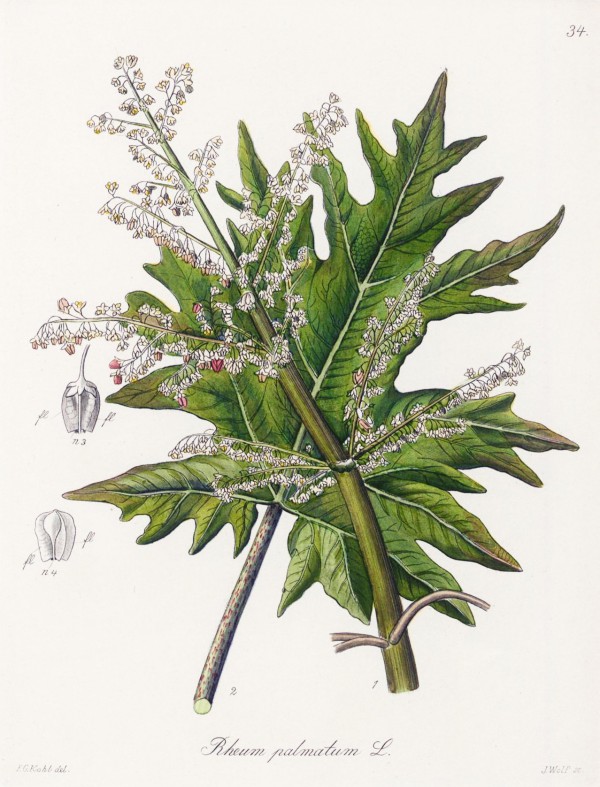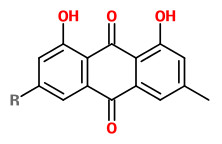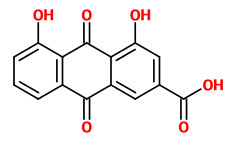Rheum palmatum L. - Polygonaceae
掌叶大黄 zhang ye da huang (chin.), Chinese rhubarb, Turkish rhubarb, Handlappiger Rhabarber, Russischer Rhabarber, Tangutischer Rhabarber, Medizinalrhabarber
Large perennial herb, 1.5-2 m tall, native to Northeast Tibet, Northwest China, cultivated in Europe; stem hollow; leaves large, as long as wide, palmately lobed; flowers small, purple-red, rarely yellow-white.
http://www.efloras.org/florataxon.aspx?flora_id=2&taxon_id=200006744
„The conditions treated by Chinese rhubarb in ancient times are the same as it is used to treat today. The root (the predominantly medicinal part of the species) is still known for its astringent capabilities (as well as a strong laxative); “the tannins in the root caused an astringent action making it useful in the early stages of diarrhea, dysentery, and other intestinal problems.“
http://en.wikipedia.org/wiki/Rheum_palmatum
„The composition of the volatile oil from the rhizomes of Rheum palmatum L. has been investigated by capillary GC, GC-MS and 1H-NMR. The oil contained 108 volatile components of which 27.3% were terpenoid. The main constituents were palmitic acid (22.5%), paeonol (16.2%), α-copaene (9.8%), methyl stearate (9.3%), δ-cadinene (5.7%) and methyl eugenol (5.4%).“
[Volatile components of the Rhizomes of Rheum palmatum L. Miyazawa, M., Minamino, Y., Kameoka, H., Flavour and fragrance journal, Vol.11(1), 1996, 57-60]
„The ultrasonic nebulization extraction (UNE) was developed and applied to extract anthraquinones (emodin, aloe-emodin and rhein) from Rheum palmatum L. … Under the selected conditions, contents of emodin, aloe-emodin and rhein obtained from different cultivated areas of R. palmatum L. were 1.08-2.04 mg/g, 0.65-1.16 mg/g and 0.70-2.90 mg/g, respectively… Compared with maceration extraction (ME), reflux extraction (RE), stirring extraction (SE) and ultrasonic extraction (UE), the proposed method was more efficient, faster and easier to be operated and lower equipment costs and lower extraction temperature were required. “
[Ultrasonic extraction and separation of anthraquinones from Rheum palmatum L., Wang, L., Li, D., Bao, C., You, J., Wang, Z., Shi, Y., Zhang, H., Ultrasonics sonochemistry, Vol.15(5), 2008, 738-746]
„… the hepatotoxic potential of rhubarb is strongly related to liver fibrosis, although this effect is undetectable when the normal dosage recommended in the Chinese Pharmacopoeia (0.5 g/kg) is administered… In conclusion, the findings of this study illustrate the bidirectional potential, both liver protection and hepatotoxicity, of rhubarb on CCl4-treated and normal rats and demonstrate the feasibility of using a multivariate analysis approach factor analysis, to study the dose-response (therapeutic efficacy versus toxicity) relationships of traditional herbal medicines by revealing the underlying interrelationships within a number of functional bio-indices in a holistic manner.“
[Hepatotoxicity or hepatoprotection? Pattern recognition for the paradoxical effect of the Chinese herb Rheum palmatum L. in treating rat liver injury. Wang, J. B., Zhao, H. P., Zhao, Y. L., Jin, C., Liu, D. J., Kong, W. J., Xiao, X. H., PloS one, 6(9), (2011), e24498] http://www.plosone.org/article/info%3Adoi%2F10.1371%2Fjournal.pone.0024498#pone-0024498-g004
Dahuang (Rhei radix et rhizoma) is used to treat complaints like „constipation, diarrhea with “heat”-signs (bloody, foul smelling stools), jaundice, painful abdomen, blood in stool, dysmenorrhea and amenorrhea, fixed pain, also after injuries…“. The quality is determined by its content of anthraquinone glycosides and anthraquinones (emodin, aloeemodin, chrysophanol, rhein, sennidin A, C), (PhPRC 2010): min. 1.5% anthrachinones
Content (PhEur): min. 2.2% hydroxyanthracene derivatives, calculated as rhein (colorimetric analysis).
http://www.lfl.bayern.de/mam/cms07/publikationen/daten/merkblaetter/chinese_medicinal_plants__cultivated_bavaria_lfl-merkblatt.pdf
The dried rhizomes of R.palmatum, R.officinale, and hybrids thereof, (Rhizoma Rhei, Radix rhei sinensis) are used for short-term treatment of obstipation. Chronic (ab)use may lead to potassium deficiency with possible reinforcement of the effect of cardiac glycosides and impairment of the action of antiarrhythmic drugs.
[Wolfgang Blaschek ed., Wichtl - Teedrogen und Phytopharmaka: Ein Handbuch für die Praxis, 2015, 550-553]

Kohl, F.G., Die officinellen Pflanzen der Pharmacopoea Germanica, t.34 (1891-1895)
http://plantgenera.org/species.php?id_species=874401


